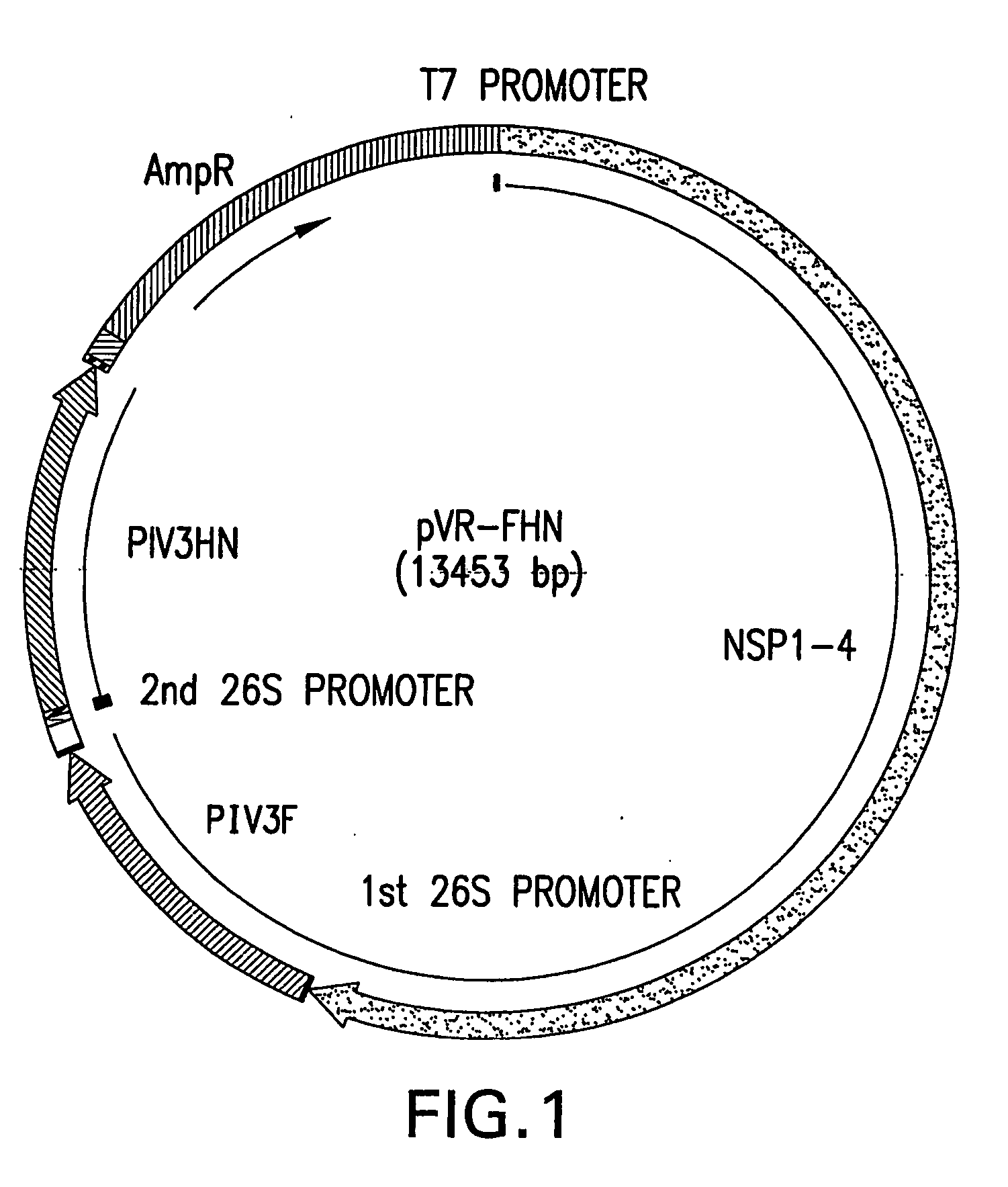Fusogenic, self-propagating blebs as immunogenic compositions
a composition and self-propagation technology, applied in the field of immunogenic compositions, can solve the problems of hampered rsv vaccine development and little success in the world economy for more than 30 years, and achieve the effect of reducing the severity of rsv infection and preventing the infection of the lower respiratory tra
- Summary
- Abstract
- Description
- Claims
- Application Information
AI Technical Summary
Benefits of technology
Problems solved by technology
Method used
Image
Examples
example 1
Plasmid Construction of VRP Expressing PIV Proteins
[0055] The present invention uses human PIV-3 as a model parainfluenza virus. Human PIV3 viral stock (Washington 47885 / 57 strain) was prepared as described previously. See Stokes, A. et al. Virus Research 25:91-103 (1992). Virus stock was purified by polyethyleneglycol (PEG) precipitation. RNA was extracted by Trizol-LS (Life Technologies) and used as template for reverse transcription PCR using the Titan One Tube RT-PCR system (Roche). Primers were used to amplify fragments spanning the entire open reading frames (ORF) of N, P, M, C, HN, and F, including a 5′ Kozak consensus sequence. The resulting fragments were then digested with the following restriction endonucleases: ClaI and HindIII for F, EcoRI and BamHI for HN, PstI and EcoRI for NP, AccI and XbaI for P and C, and HindIII and XbaI for M. The resultant fragments were cloned into the shuttle plasmid, pKSR1. Subsequently, ApaI-ORF-NotI cassettes from the shuttle plasmids were...
example 2
VRP Production
[0057] This example describes how VRPs were generated that expressed each of the antigens of PIV3 by electroporating RNA from the plasmids constructed in Example 1 into BHK21 cells. The original VEE plasmid pVR100, and two helper plasmid pHC(capsid) and pHC(gp E1 / E2) were obtained from AlphaVax (Durham, N.C.). See Pushko et al. Virology 239:389-401 (1997), the disclosure of which is hereby incorporated by reference in its entirety. RT-PCR fragments of the PIV3 glycoprotein genes were cloned into pVR200 individually or pVR100 (HN and F together). The generated plasmids were then subjected to in vitro transcription to generate RNAs. The RNAs were subsequently electroporlated into BHK21 cells to generate VRPs that encoded either NP, M, P, C, F and / or HN genes (VRP-NP, -M, -P, -C, -HN, -F, -F / HN), respectively.
[0058] After obtaining the individual PIV genes and cloning them into suitable expression vectors, capped RNA transcripts were then prepared in vitro using NotI li...
example 3
Virus Titers of VRPs and PIV
[0059] VEE replicons (VRPs) expressing PIV proteins and glycoproteins were titrated by immunohistochemistry methods. The VRPs were propagated in BHK-21 lineage. In this case, BHK cells were derived from a CCL-10 clone to distinguish them from other BHK clonal populations that may not share the shame phenotypic characteristics. As defined herein, the cells may be referred to as BHK21 or simply BHK cells. BHK21 monolayers were infected with serial diluted VEE replicons: VRP-NP; VRP-P; VRP-M; VRP-C; VRP-HN; VRP-F; VRP-F / HN and VRP-GFP, and incubated at 37° C. for 16-20 hours. Monolayers were then fixed with 1:1 Acetone / Methanol for 5 minutes and stained with either rabbit anti-VEE NSP1 protein which was expressed from bacteria, polyclonal Ab r835 or horse anti-PIV3 serum. Plaques were then detected by either cyTM3 conjugated goat anti-rabbit antibody (Jackson ImmunoResearch, West Grove, Pa.) or Horseradish peroxidase (HOURP) conjugated anti-horse Ab (Kirkeg...
PUM
| Property | Measurement | Unit |
|---|---|---|
| size | aaaaa | aaaaa |
| time period | aaaaa | aaaaa |
| size | aaaaa | aaaaa |
Abstract
Description
Claims
Application Information
 Login to View More
Login to View More - R&D
- Intellectual Property
- Life Sciences
- Materials
- Tech Scout
- Unparalleled Data Quality
- Higher Quality Content
- 60% Fewer Hallucinations
Browse by: Latest US Patents, China's latest patents, Technical Efficacy Thesaurus, Application Domain, Technology Topic, Popular Technical Reports.
© 2025 PatSnap. All rights reserved.Legal|Privacy policy|Modern Slavery Act Transparency Statement|Sitemap|About US| Contact US: help@patsnap.com

